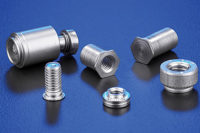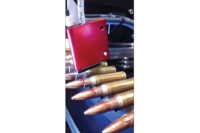Fastening Solutions for Thin-Walled Applications

It is important that these factors be considered early in the design of an application, rather than as an afterthought, to ensure optimal joint performance.
Thin-walled components
In addition to the previous design factors, thin-walled components present additional challenges in joint design. The first is thread engagement.Fastening directly into thin-walled materials is often impractical due to a lack of material in which to obtain sufficient thread engagement. The screws generally used in thin-walled applications are widely pitched screws, which offer only one thread of engagement.
In many cases, the screw will strip immediately after seating. This gives a very small window for tightening torque.
In other scenarios, the minimal material thickness combined with a very thin clamped material can lead to problems with fastening in the runout portion of the screw. This is the area of the fastener where the threads are not fully formed and, therefore, a secure joint cannot be guaranteed.
Another difficulty with fastening thin-walled applications can be deformation of the assembly. In some cases, the force required in the installation process can cause deformation of the material to be assembled, thus affecting the function or appearance of the application.
Current techniques
The current systems for fastening thin-walled applications are numerous, but fairly limited in terms of performance. The most common are stamped metal clips, in a U- or J-shape, that slide onto a panel and are fastened with a machine or a pitched screw. In addition, some of the pitched screws fasten directly into a panel which has the helix of the fastener punched into it.There are also fasteners that do not require a prepunched hole, such as self-drilling screws.
Other methods include the standard nut and bolt pair, welding (ultrasonic welding for plastics), adhesives, perforations, bending, and rivets.
All of these methods have some disadvantages. Metal clips can be very expensive and often require some type of prevailing torque device, especially in applications subject to vibration. These clips can be prone to corrosion, as well as hydrogen embrittlement.
Welding, riveting, and adhesives are permanent, preventing simple servicing and repair.
Screws that fasten directly into thin-walled panels tend to be poor performers due to a lack of thread engagement.
Innovations
As wall thicknesses are decreasing, new fastening techniques are in development to address the potential problems these assemblies can present.Specifically, two new types of clips have been developed for use in these thin-walled applications. The first is a slide-in plastic boss, similar in function to the J-clip. The other is a snap-in plastic floating boss, a new and completely unique design.
The main reason these bosses are innovative is that they utilize the features and benefits of plastic. This provides many advantages and increases design flexibility.
Using plastic in the construction of these bosses eliminates many of the problems seen with the current techniques. Plastic eliminates the possibility of hydrogen embrittlement in the clip and galvanic corrosion between the panel and the fastener. Plastic also significantly reduces weight in the application and is fully recyclable.
The EASYbossR
As mentioned earlier, the U- or J-shape is a popular and useful design for slide-in bosses. By making the boss from a thermoplastic material and increasing the boss depth, the long-term performance of the joint is significantly improved.Similar to the standard J- or U-clip, the EASYboss can slide in place over a punched hole that needs no modification, as shown in Figure 1. This allows quick and easy assembly without added expense or time.
The standard metal clip has the helix of the male fastener stamped in the pilot hole, allowing for only one thread of engagement.
With the EASYboss, optimal thread engagement is achieved when used with the ATF PTR screw, designed for threadforming into thermoplastics (Figure 2). This provides for a high safety of assembly, as the window between the driving torque and stripping torque is large enough to determine a safe tightening torque and to account for screwdriver repeatability. The fastener can be tightened to the same torque (plus or minus a given percentage, approximately 20 percent), and the screw will always seat but will never strip.
The increased thread engagement of the EASYboss also enables the maintenance of a steady clamp load. The metal clips with the stamped helix only provide one thread of engagement. Therefore, if that thread is lost, all clamp load in the joint is lost. The captured material can subsequently loosen, and squeaks and rattles can become prevalent.
A significant advantage of the plastic EASYboss is the increased corrosion resistance it provides. In a metal application, the boss acts as an insulator between the metal fastener and the metal panel, thus eliminating the possibility of galvanic corrosion. The plastic material is also completely recyclable. When used in a plastic panel, the EASYboss material can be matched to that of the application to ease recycling procedures.
The VARIObossR
In some cases, a slide-in boss is not practical. There are difficulties with automation, and often the geometry of the application will not permit the sliding motion. In these cases, a snap-in type of fastening system that can be installed with a simple pushing motion is the ideal solution.The VARIOboss (Figure 3) meets these requirements and again offers advantages similar to those of the EASYboss: corrosion resistance, recyclability, and safety of assembly.
An important benefit of the VARIOboss is its ability to absorb both horizontal and vertical tolerances. Due to the unique construction, the inner screw boss actually floats within the housing. Figure 4 shows the elements of the VARIOboss.
The springs allow the distance between the top flange and the inner boss to vary up to 2.0 millimeters. One model of the VARIOboss can be used with panel thicknesses from 0.5 mm to 2.5 mm. In addition, the boss can move in the horizontal direction as well, reducing problems with alignment of through holes in clamped material.
Installation of the VARIOboss is simple and well-suited for automation. The boss is inserted, manually or with a pneumatic gun, into a square prepunched hole, as shown in Figure 5. These two flanges pass through the square hole and snap into place on the underside of the panel, providing resistance to any pull-out force.
The springs at the bottom of the unit then exert force on the inner boss so that a gap does not exist between the main flange above the panel and the two flanges below the panel (Figure 6). The clamped material can now be fastened with the same ATF PT fastener used in the EASYboss.
Conclusion
While fastening into thin-walled materials can present many difficulties, new solutions are rapidly being developed. These solutions can be improvements on familiar designs, as with the EASYboss, or can be found in completely new innovations, as demonstrated by the VARIOboss.When designing a joint for a thin-walled application, the designer must consider the standard guidelines for joint optimization along with the added challenges these materials can present.
With the new technology available and proper attention to the characteristics of the application, a safe, secure joint can be expected with every assembly.
Looking for a reprint of this article?
From high-res PDFs to custom plaques, order your copy today!




